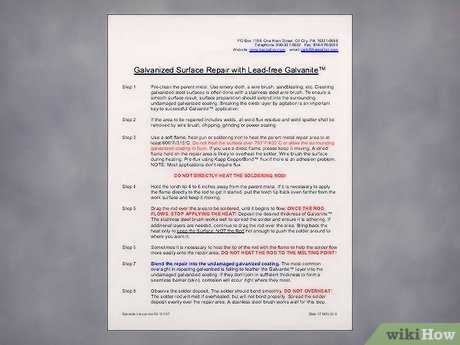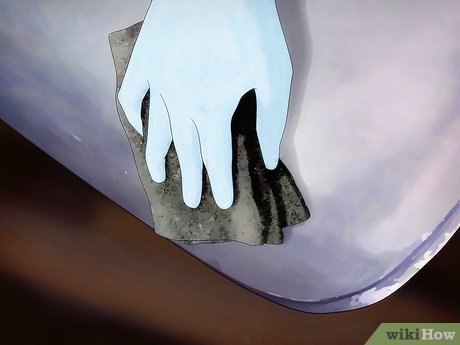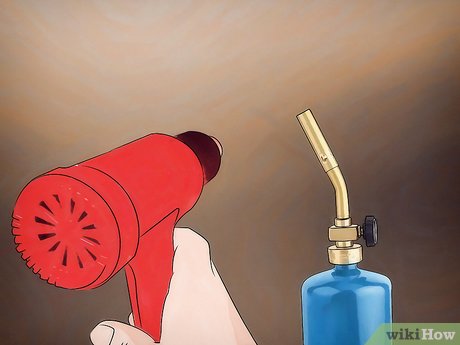How to Repair Galvanized Coatings
Galvanized coatings on steel are routinely damaged during welding, cutting, and transport. They must be repaired, or else the damage will result in rusting. There are three specific ways to repair the coating. Be sure that you have the...
Method 1 of 3:
Repair Using Zinc Based Alloys
-
 Be sure that you have the Galvanite Instructions and be sure to read them.
Be sure that you have the Galvanite Instructions and be sure to read them. -
 Pre-clean the parent metal. Use these items: emery cloth, a wire brush, sandblasting, etc. Cleaning galvanized steel surfaces is often done with a stainless steel wire brush. To ensure a smooth surface result, surface preparation should extend into the surrounding undamaged galvanized coating. Breaking the oxide layer by agitation is an important key to successful galvanizing repair. If the area to be repaired includes welds, all weld flux residue and weld spatter shall be removed by wire brush, chipping, grinding or power scaling.
Pre-clean the parent metal. Use these items: emery cloth, a wire brush, sandblasting, etc. Cleaning galvanized steel surfaces is often done with a stainless steel wire brush. To ensure a smooth surface result, surface preparation should extend into the surrounding undamaged galvanized coating. Breaking the oxide layer by agitation is an important key to successful galvanizing repair. If the area to be repaired includes welds, all weld flux residue and weld spatter shall be removed by wire brush, chipping, grinding or power scaling. -
 Use a soft flame, heat gun or soldering iron to heat the parent metal repair area to at least 600°F/315°C. Do not heat the surface over 750°F/400°C or allow the surrounding galvanized coating to burn. If you use a direct flame, keep it moving. A direct flame held on the repair area is likely to overheat the solder. Wire brush the surface during heating. Pre-flux using flux if there is an adhesion problem. NOTE: Many applications do not require flux.
Use a soft flame, heat gun or soldering iron to heat the parent metal repair area to at least 600°F/315°C. Do not heat the surface over 750°F/400°C or allow the surrounding galvanized coating to burn. If you use a direct flame, keep it moving. A direct flame held on the repair area is likely to overheat the solder. Wire brush the surface during heating. Pre-flux using flux if there is an adhesion problem. NOTE: Many applications do not require flux. -
 Hold the torch tip 4 to 6 inches (10.2 to 15.2 cm) away from the parent metal. If it is necessary to apply the flame directly to the rod to get it started, pull the torch tip back even farther from the work surface and keep it moving.
Hold the torch tip 4 to 6 inches (10.2 to 15.2 cm) away from the parent metal. If it is necessary to apply the flame directly to the rod to get it started, pull the torch tip back even farther from the work surface and keep it moving. -
 Drag the rod over the area to be soldered, until it begins to flow. Once the rod flows, stop applying the heat. Deposit the desired thickness of galvanizing repair rod. A stainless steel brush works well to spread the solder and ensure it is adhering. If additional layers are needed, continue to drag the rod over the area.
Drag the rod over the area to be soldered, until it begins to flow. Once the rod flows, stop applying the heat. Deposit the desired thickness of galvanizing repair rod. A stainless steel brush works well to spread the solder and ensure it is adhering. If additional layers are needed, continue to drag the rod over the area.- Bring back the heat only to keep the surface, not the rod, hot enough to push the solder around to where you want it.
-
 Blend the repair into the undamaged galvanized coating. The most common oversight in repairing galvanized is failing to feather the galvanizing repair material layer into the undamaged galvanized coating. If they don't join in sufficient thickness to form a seamless barrier (skin), corrosion will occur right where they meet.
Blend the repair into the undamaged galvanized coating. The most common oversight in repairing galvanized is failing to feather the galvanizing repair material layer into the undamaged galvanized coating. If they don't join in sufficient thickness to form a seamless barrier (skin), corrosion will occur right where they meet. -
 Observe the solder deposit. The solder should bond smoothly. Do not overheat, the solder rod will melt if overheated, but will not bond properly. Spread the solder deposit evenly over the repair area. A stainless steel brush works well for this step.
Observe the solder deposit. The solder should bond smoothly. Do not overheat, the solder rod will melt if overheated, but will not bond properly. Spread the solder deposit evenly over the repair area. A stainless steel brush works well for this step. -
 If you stopped soldering and want to apply more solder or flow out the deposit more, let the area cool below the solid temperature and reheat. The existing coating will help the bonding process, whether adding more solder or just flowing out the previous deposit.
If you stopped soldering and want to apply more solder or flow out the deposit more, let the area cool below the solid temperature and reheat. The existing coating will help the bonding process, whether adding more solder or just flowing out the previous deposit.- If substantial time has elapsed since the original repair layer was applied, pre-clean the repair area again to remove any oxide coating that will impair bonding. Again, a stainless steel brush works well for this step.
-
 Smooth the repair area and remove any excess solder with a wire brush.
Smooth the repair area and remove any excess solder with a wire brush. -
 Repeat these steps to build up additional layers of protection.
Repeat these steps to build up additional layers of protection. -
 Gather the materials below:
Gather the materials below:- Common Zinc based alloys
- Zinc-Cadmium – Liquid temperature - 509°F-600°F (265°C-316°C)[1]
- Tin-Zinc-Lead – Liquid temperature - 350°F-550°F (177°C-288°C)[2]
- Tin-Zinc-Copper – Liquid temperature - 390°F-570°F (200°C-300°C)[3]
- Propane or MAP Gas torch is recommended
- Stainless steel or wire brush
- Common Zinc based alloys
Method 2 of 3:
Repair Procedures Using Paint Containing Zinc Dust
-
 Repair of damaged hot dip galvanized coatings. [4]
Repair of damaged hot dip galvanized coatings. [4]- These types of paints contain zinc dust and are suitable for repairing damaged galvanized coatings provided the paint containing zinc dust shall have a concentration of zinc dust in the range of at least 65-69% or above 92% in the dried film.
- Repair surfaces with paint containing zinc dust shall be clean, dry, free of oil, grease, pre-existing paint, corrosion, and/or rust.
- Clean surfaces in according with the requirements of SSPC SP10 (near-white). Where circumstances do not allow blast or power tool cleaning to be used, then hand tools may be used. Cleaning should meet the requirements of SSPC SP2 (removal of loose rust, mil scale, or paint to the degree specified, by hand chipping, crapping, sanding, and wire-brushing)
- To ensure that a smooth reconditioned coating can be affected, surface preparation shall extend into the undamaged galvanized coating.
- If the areas/surfaces to be repaired include welds, first remove all weld flux residue and weld spatter by blasting, chipping, grinding or power scaling, etc.
-
 Spray or brush-apply the paints containing zinc dust to the prepared surfaces/areas. Apply the paint in accordance with the manufacturer's recommendations in a single application employing multiple passes to achieve a dry film thickness as specified.
Spray or brush-apply the paints containing zinc dust to the prepared surfaces/areas. Apply the paint in accordance with the manufacturer's recommendations in a single application employing multiple passes to achieve a dry film thickness as specified. -
 Allow adequate curing time before shipping or subjecting the repaired items to service. The cure shall be in accordance with manufacturer's recommendations.
Allow adequate curing time before shipping or subjecting the repaired items to service. The cure shall be in accordance with manufacturer's recommendations.- Thickness shall be adequate and/or as originally specified
- Note that Zinc-rich paint is not considered as a galvanized coating. Also known as "cold galvanizing"
-
 Get zinc containing paint. It comes in spray, or brush on variants.
Get zinc containing paint. It comes in spray, or brush on variants.
Method 3 of 3:
Repair With Sprayed Zinc (Metalizing)
-
 Repair of damaged hot dip galvanized coatings, [5]
Repair of damaged hot dip galvanized coatings, [5]- This method is not for field application and cannot be used in the field. This method involves the application of a zinc coating by spraying the surface to be repaired with droplets of molten metal using wire, ribbon, or powder processes. Must contact a metalizing shop.
- Surfaces to be repaired by zinc metalizing process shall be clean, free of soil, grease, and corrosion products, and dry.
- If areas/surfaces to be repaired include welds, first remove all flux residues and weld spatter of a size or type that cannot be removed by blast cleaning or by mechanical means, that is chipping, grinding or power scaling.
-
 Blast clean the surface to be reconditioned in accordance with the requirements of SSPC SP5 (white metal).
Blast clean the surface to be reconditioned in accordance with the requirements of SSPC SP5 (white metal). -
 To assure that a smooth reconditioned coating can be affected, surface preparation shall extend into the surrounding, undamaged galvanized coating.
To assure that a smooth reconditioned coating can be affected, surface preparation shall extend into the surrounding, undamaged galvanized coating. -
 Apply the coating by means of metal spraying pistols fed with either zinc wire or zinc powder. Apply the sprayed coating as soon as possible after surface preparation and before visible deterioration of the surface has occurred.
Apply the coating by means of metal spraying pistols fed with either zinc wire or zinc powder. Apply the sprayed coating as soon as possible after surface preparation and before visible deterioration of the surface has occurred.- The surface of the sprayed coating shall be of a uniform texture, free of lumps, coarse areas and loosely adherent particles.
- The nominal thickness of the sprayed zinc coating shall be adequate and as specified.
4 ★ | 1 Vote
You should read it
- The great effects of zinc for men
- Which Zinc pills are good for men should be supplemented
- Top 7 foods that contain the most zinc
- New parylene coating technology helps computers work underwater
- Microsoft repair free Surface Laptop 3 'cracked hairline'
- Compare Microsoft Surface 3 and Surface Pro 3
- Diets high in zinc may increase the risk of infection with C. Difficile
- Surface Pro 3 receives new updates, improves drivers for the Surface Pen
- Surface Book 3 officially launched, becoming the most powerful Surface
- Silver batteries minimize the risk of explosion
- Microsoft is developing a low-cost Surface computer running Windows 11 SE
- Microsoft: Surface Pro 3 sales exceeded expectations






















 Fix Windows startup errors with Startup Repair
Fix Windows startup errors with Startup Repair Fast fix computer repair on Windows
Fast fix computer repair on Windows Top 5 best kits for professional car mechanics
Top 5 best kits for professional car mechanics Fsutil repair command in Windows
Fsutil repair command in Windows Repair-bde command in Windows
Repair-bde command in Windows